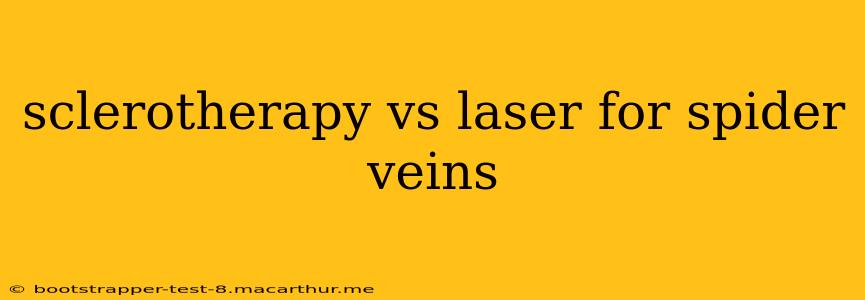Spider veins, those tiny, bluish-purple or red veins that sprawl across the skin's surface, are a common cosmetic concern. While they're generally harmless, many people seek treatment to improve their appearance. Two popular methods for eliminating spider veins are sclerotherapy and laser treatment. Choosing the best option depends on several factors, including vein size, location, skin tone, and personal preferences. This comprehensive guide will delve into the specifics of each treatment, helping you make an informed decision.
What is Sclerotherapy?
Sclerotherapy is a minimally invasive procedure that involves injecting a solution directly into the spider vein. This solution, a sclerosing agent, irritates the vein's lining, causing it to collapse and eventually fade from view. The body then absorbs the closed-off vein over time. This method is particularly effective for smaller spider veins and reticular veins (slightly larger than spider veins).
Advantages of Sclerotherapy:
- Highly effective: Sclerotherapy boasts a high success rate for treating smaller spider veins.
- Minimally invasive: It requires no incisions or general anesthesia.
- Relatively quick: Treatment sessions are usually short.
- Cost-effective: It's often less expensive than laser treatment, particularly for treating multiple veins.
Disadvantages of Sclerotherapy:
- Multiple sessions may be needed: Complete vein clearance often requires several treatment sessions.
- Potential side effects: These can include temporary bruising, swelling, pain, and discoloration. Rarely, more serious complications can occur.
- Not suitable for all vein types: It's less effective for larger veins or those located close to the skin's surface.
What is Laser Treatment for Spider Veins?
Laser treatment uses intense pulsed light (IPL) or a laser beam to target and destroy the spider veins. The heat from the laser damages the vein walls, causing them to collapse and be absorbed by the body. This method can be used to treat both spider and larger reticular veins.
Advantages of Laser Treatment:
- Treats multiple veins simultaneously: Laser can cover a larger area in a single session.
- Less bruising: Compared to sclerotherapy, laser treatment often results in less bruising.
- Suitable for various skin tones: Advances in laser technology have made it more adaptable to different skin types.
Disadvantages of Laser Treatment:
- Higher cost: Laser treatment is typically more expensive per session than sclerotherapy.
- Multiple sessions may be needed: Similar to sclerotherapy, multiple treatments might be required for optimal results.
- Potential side effects: These include temporary redness, swelling, and blistering.
Which Treatment is Better for Me?
The best treatment option depends on individual factors. A consultation with a dermatologist or phlebologist is crucial to determine the most suitable approach. They will assess your vein size, location, skin type, and overall health to recommend the most effective and safe treatment.
How Long Does Each Treatment Take?
Sclerotherapy: Each treatment session typically takes 15-30 minutes, depending on the number and size of the veins being treated.
Laser Treatment: Treatment time varies depending on the area being treated, but sessions generally last from 15 to 45 minutes.
How Many Treatments Will I Need?
The number of treatments required for both sclerotherapy and laser treatment varies depending on the individual. It often takes several sessions to achieve optimal results. Your doctor will provide a personalized treatment plan.
What are the Risks and Side Effects of Each Treatment?
Both sclerotherapy and laser treatment carry potential risks and side effects, although these are usually mild and temporary. These can include bruising, swelling, pain, discoloration, and rarely, more serious complications. A thorough discussion of these risks with your doctor is essential before undergoing either procedure.
Are There Any Alternatives to Sclerotherapy and Laser Treatment?
While sclerotherapy and laser treatment are the most common options, other methods for treating spider veins exist, including topical creams and ointments. However, these are generally less effective than the two main procedures discussed above. It is vital to consult your physician to discuss all available treatment options and their potential risks and benefits.
Conclusion
Choosing between sclerotherapy and laser treatment for spider veins depends on individual circumstances. A consultation with a qualified healthcare professional is crucial to determine the most appropriate approach. This involves a thorough evaluation of your specific needs and expectations to ensure you receive the best possible treatment and achieve optimal results. Remember that while both methods can effectively reduce the appearance of spider veins, achieving completely clear skin often requires multiple sessions.
